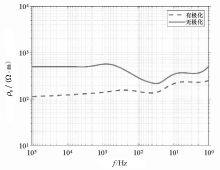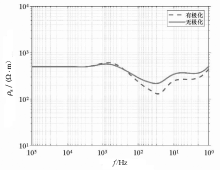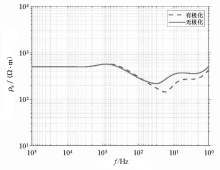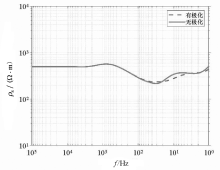|
|
|
| Visualization design of 1D CSAMT forward modeling and research on the induced polarization effect |
ZHONG Hua1,2( ), TANG Xin-Gong1,2( ), TANG Xin-Gong1,2( ) ) |
1. Key Laboratory of Exploration Technologies for Oil and Gas Resources (Yangtze University), Ministry of Education, Wuhan 430100, China
2. Hubei Collaborative Innovation Center for Unconventional Oil and Gas in Yangtze University, Wuhan 430100, China |
|
|
|
|
Abstract This study developed a piece of visualization software of the 1D data forward modeling applicable to the controlled source audio-frequency magnetotellurics (CSAMT). This software has the advantages of friendly interfaces and simple operations. In detail, MATLAB was used to develop the core algorithms, and linear filter coefficients were introduced to solve Hankel integral in the process of forward modeling. Meanwhile, the accuracy of schemes using different linear filter coefficients was compared. The operation interfaces were designed using Java, and multi-parameter setting interfaces with a high automation degree are available. Moreover, the data processing results can be intuitively provided to users using the drawing function of the software. In the calculation process, Cole-Cole model parameters were introduced, and complex resistivity was used to replace the DC resistivity without considering the polarization effect of geoelectric bodies. Furthermore, this study carried out the forward simulation of CSAMT field source on a one-dimensional layered model of induced polarization (IP) media and discussed the IP effect of one-dimensional layered media with polarization layers at different burial depths. It was found that the frequency band of CSAMT affected by the IP effect widened with a decrease in the burial depth of polarization layers. This result is crucial to understanding the electromagnetic response characteristics of the CSAMT method with IP effect and improving the convenience and efficiency of data processing.
|
|
Received: 12 July 2021
Published: 28 June 2022
|
|
|
|
Corresponding Authors:
TANG Xin-Gong
E-mail: 3332706538@qq.com;tangxg@yangtzeu.edu.cn
|
|
|
|

|
Schematic diagram of electric dipole horizontal layered medium model
|

|
Parameter input interface
|

|
Import file selection interface
|

|
Error message prompt interface
|

|
Graphic interface
|

| K型结构 | 电阻率/(Ω·m) | 层厚度/m | | 第一层 | 300 | 300 | | 第二层 | 1000 | 600 | | 第三层 | 200 | ∞ |
|
Parameter setting of K geoelectric model
|

|
Apparent resistivity of the K-type geoelectric model when the polarization layer is located in the shallow layer
|

|
Apparent resistivity of the K-type geoelectric model when the polarization layer is located in the middle layer
|

|
Apparent resistivity of the K-type geoelectric model when the polarization layer is located in the deep layer
|

| K型结构 | 电阻率/(Ω·m) | 层厚度/m | | 第一层 | 500 | 200 | | 第二层 | 300 | 100 | | 第三层 | 1000 | 500 | | 第四层 | 200 | ∞ |
|
Parameter setting of HK geoelectric model
|

|
Apparent resistivity of HK-type geoelectric model when the polarization layer is located in the first layer
|

|
Apparent resistivity of HK-type geoelectric model when the polarization layer is located in the second layer
|

|
Apparent resistivity of HK-type geoelectric model when the polarization layer is located in the third layer
|

|
Apparent resistivity of HK-type geoelectric model when the polarization layer is located in the fourth layer
|

| QQ型结构 | 电阻率/(Ω·m) | 层厚度/m | | 第一层 | 1000 | 500 | | 第二层 | 300 | 500 | | 第三层 | 100 | 500 | | 第四层 | 50 | ∞ |
|
Parameter setting of QQ geoelectric model
|

|
Apparent resistivity of QQ-type geoelectric model when the polarization layer is located in the first layer
|

|
Apparent resistivity of QQ-type geoelectric model when the polarization layer is located in the second layer
|

|
Apparent resistivity of QQ-type geoelectric model when the polarization layer is located in the third layer
|

|
Apparent resistivity of QQ-type geoelectric model when the polarization layer is located in the fourth layer
|

| HAK型结构 | 电阻率/(Ω·m) | 层厚度/m | | 第一层 | 500 | 500 | | 第二层 | 50 | 100 | | 第三层 | 200 | 800 | | 第四层 | 1000 | 1000 | | 第五层 | 100 | ∞ |
|
Parameter setting of HAK geoelectric model
|

|
Apparent resistivity of HAK-type geoelectric model when the polarization layer is located in the first layer
|

|
Apparent resistivity of HAK-type geoelectric model when the polarization layer is located in the second layer
|

|
Apparent resistivity of HAK-type geoelectric model when the polarization layer is located in the third layer
|

|
Apparent resistivity of HAK-type geoelectric model when the polarization layer is located in the fourth layer
|
| [1] |
龚强, 胡祥云, 孟永良. 基于快速汉克尔变换算法的CSAMT一维正演[J]. 煤田地质与勘探, 2008, 36(1):71-73.
|
| [1] |
Gong Q, Hu X Y, Meng Y L. Linear dimension forward solution of CSAMT by Hankel transformation method[J]. Coal Geology & Exploration, 2008, 36(1):71-73.
|
| [2] |
汤井田, 何继善. 可控源音频大地电磁法及其应用[M]. 长沙: 中南大学出版社, 2005.
|
| [2] |
Tang J T, He J S. Theory and application of CSAMT method[M]. Changsha: Central South University, 2005.
|
| [3] |
王佳宝. CSAMT二维反演程序设计与实现[D]. 北京: 中国地质大学(北京), 2016.
|
| [3] |
Wang J B. Design and implementation of CSAMT two-dimensional inversion program[D]. Beijing: China University of Geosciences, 2016.
|
| [4] |
张健. 可控源音频大地电磁法一维正反演研究[D]. 成都: 成都理工大学, 2011.
|
| [4] |
Zhang J. Research on one-dimensional forward and inversion of CSAMT method[D]. Chengdu: Chengdu University of Technology, 2011.
|
| [5] |
王珺璐, 刘明文, 李荡, 等. 基于Cole-Cole复电阻率模型的线源可控源有限元数值模拟[J]. 物探化探计算技术, 2015, 37(1):32-39.
|
| [5] |
Wang J L, Liu M W, Li D, et al. Finite element numerical simulation on line controlled source based on Cole-Cole model[J]. Computing Techniques for Geophysical and Geochemical Exploration, 2015, 37(1):32-39.
|
| [6] |
唐睿, 唐新功, 于鹏. CSAMT正演模拟中激电效应的初步研究[C]// 第十届中国国际地球电磁学术讨论会论文集, 2011.
|
| [6] |
Tang R, Tang X G, Yu P. The preliminary research on IP effect in CSAMT[C]// Proceedings of The 10th China International Geo-Electromagnetic Workshop, 2011.
|
| [7] |
岳安平, 底青云, 王妙月, 等. 油气藏MT激电效应一维正演研究[J]. 石油地球物理勘探, 2009, 44(3):364-370.
|
| [7] |
Yue A P, Di Q Y, Wang M Y, et al. 1D forward simulation of MT IP effect of reservoir[J]. Oil Geophysical Prospecting, 2009, 44(3):364-370.
|
| [8] |
徐玉聪. 含激电效应的CSAMT一维正反演研究[D]. 成都: 成都理工大学, 2016.
|
| [8] |
Xu Y C. Research on IP effect of one-dimensional forward and inversion of CSAMT[D]. Chengdu: Chengdu University of Technology, 2016.
|
| [9] |
侯海涛. Cole-Cole模型等效模拟瞬变电磁响应[D]. 长沙: 中南大学, 2010.
|
| [9] |
Hou H T. Transient electromagnetic simulation response of Cole-Cole model equivalent[D]. Changsha: Central South University, 2010.
|
| [10] |
耿祥义, 张跃平. Java面向对象程序设计[M]. 北京: 清华大学出版社, 2010.
|
| [10] |
Geng X Y, Zhang Y P. Java object-oriented programming[M]. Beijing: Tsinghua University, 2010.
|
| [11] |
余传涛. 含激电效应的CSAMT二维正演与联合反演应用研究[D]. 太原: 太原理工大学, 2012.
|
| [11] |
Yu C T. 2D Forward modeling and joint inversion of the CSAMT signal incorporation IP effect[D]. Taiyuan: Taiyuan University of Technology, 2012.
|
| [12] |
蔡盛. 快速汉克尔变换及其在电法正演计算中的应用研究[D]. 长沙: 中南大学, 2013.
|
| [12] |
Cai S. The fast hankel transformation and its applications in electrical exploration forward calculations[D]. Changsha: Central South University, 2013.
|
| [13] |
蔡盛. 快速汉克尔变换及其在正演计算中的应用[J]. 地球物理学进展, 2014, 29(3):1384-1390.
|
| [13] |
Cai S. Fast Hankel transformation and its application in forward computing[J]. Progress in Geophysics, 2014, 29(3):1384-1390.
|
| [14] |
胡俊, 聂在平. 索末菲尔德积分新方法——快速汉克尔变换[J]. 电子学报, 1998(3):126-128.
|
| [14] |
Hu J, Nie Z P. A new method to calculate Sommerfeld integral:Fast hankel transform[J]. Acta Electronica Sinica, 1998(3):126-128.
|
| [15] |
底青云, 王若. 可控源音频大地电磁数据正反演及方法应用[M]. 北京: 科学出版社, 2008.
|
| [15] |
Di Q Y, Wang R. Forward and inversion of CSAMT data and its application[M]. Beijing: Science Press, 2008.
|
| [1] |
YOU Yue-Xin, DENG Ju-Zhi, CHEN Hui, YU Hui, GAO Ke-Ning. Application of integrated geophysical methods in deep ore prospecting of Laochang polymetallic mining area in Lancang, Yunnan[J]. Geophysical and Geochemical Exploration, 2023, 47(3): 638-647. |
| [2] |
WANG Fei-Fei, CHEN Ru-Jun, LI Sheng-Jie, SHEN Rui-Jie, YIN Hao, LIU Feng-Hai, PENG Xin. Development of the acquisition system of a broadband spectral induced polarization testers for rock and ore samples[J]. Geophysical and Geochemical Exploration, 2022, 46(6): 1454-1462. |
|
|
|
|

